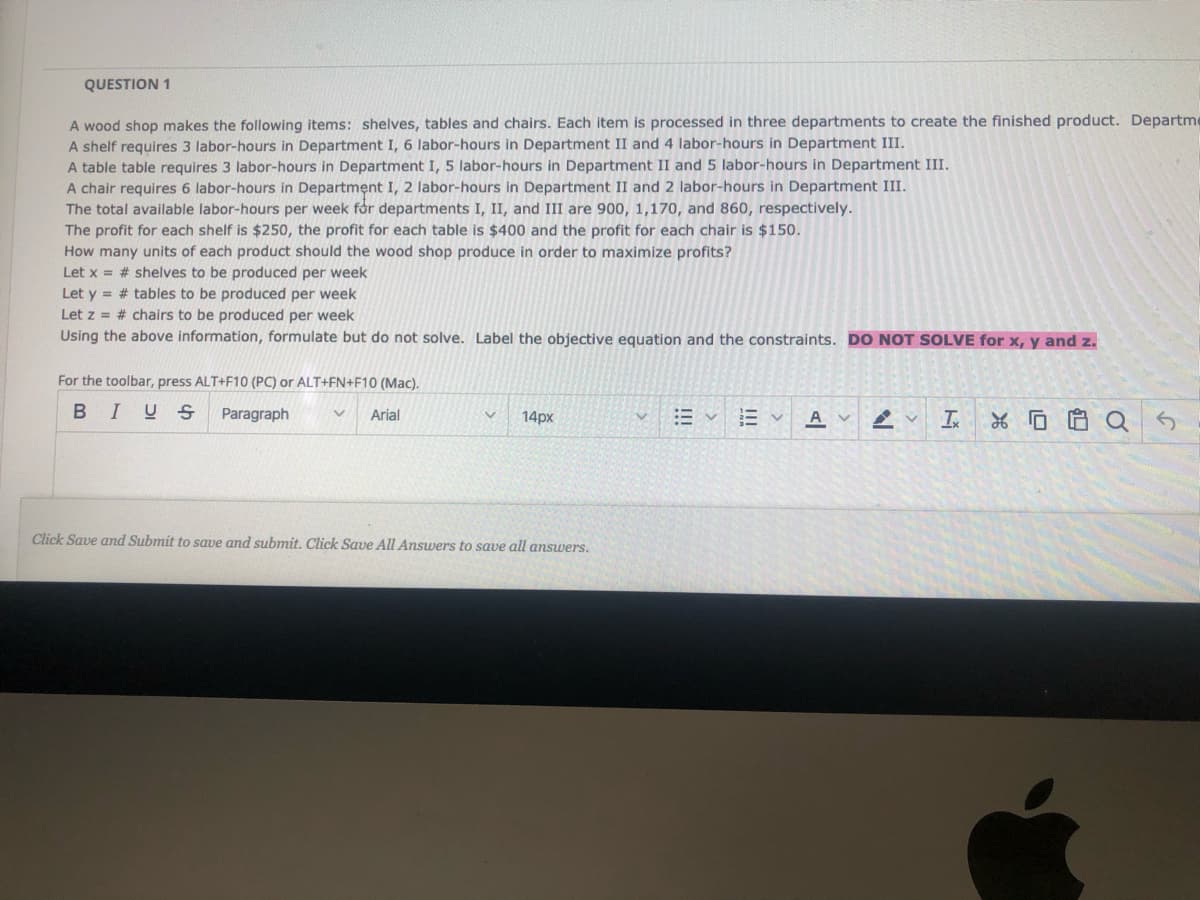A wood shop makes the following items: shelves, tables and chairs. Each item is processed in three departments to create the finished product. C A shelf requires 3 labor-hours in Department I, 6 labor-hours in Department II and 4 labor-hours in Department III. A table table requires 3 labor-hours in Department I, 5 labor-hours in Department II and 5 labor-hours in Department III. A chair requires 6 labor-hours in Department I, 2 labor-hours in Department II and 2 labor-hours in Department III. The total available labor-hours per week for departments I, II, and III are 900, 1,170, and 860, respectively. The profit for each shelf is $250, the profit for each table is $400 and the profit for each chair is $150. How many units of each product should the wood shop produce in order to maximize profits? Let x = # shelves to be produced per week Let y = # tables to be produced per week Let z = # chairs to be produced per week Using the above information, formulate but do not solve. Label the objective equation and the constraints. DO NOT SOLVE for x, y and z.
A wood shop makes the following items: shelves, tables and chairs. Each item is processed in three departments to create the finished product. C A shelf requires 3 labor-hours in Department I, 6 labor-hours in Department II and 4 labor-hours in Department III. A table table requires 3 labor-hours in Department I, 5 labor-hours in Department II and 5 labor-hours in Department III. A chair requires 6 labor-hours in Department I, 2 labor-hours in Department II and 2 labor-hours in Department III. The total available labor-hours per week for departments I, II, and III are 900, 1,170, and 860, respectively. The profit for each shelf is $250, the profit for each table is $400 and the profit for each chair is $150. How many units of each product should the wood shop produce in order to maximize profits? Let x = # shelves to be produced per week Let y = # tables to be produced per week Let z = # chairs to be produced per week Using the above information, formulate but do not solve. Label the objective equation and the constraints. DO NOT SOLVE for x, y and z.
Linear Algebra: A Modern Introduction
4th Edition
ISBN:9781285463247
Author:David Poole
Publisher:David Poole
Chapter2: Systems Of Linear Equations
Section2.4: Applications
Problem 28EQ
Related questions
Concept explainers
Contingency Table
A contingency table can be defined as the visual representation of the relationship between two or more categorical variables that can be evaluated and registered. It is a categorical version of the scatterplot, which is used to investigate the linear relationship between two variables. A contingency table is indeed a type of frequency distribution table that displays two variables at the same time.
Binomial Distribution
Binomial is an algebraic expression of the sum or the difference of two terms. Before knowing about binomial distribution, we must know about the binomial theorem.
Topic Video
Question
Q1

Transcribed Image Text:QUESTION 1
A wood shop makes the following items: shelves, tables and chairs. Each item is processed in three departments to create the finished product. Departme
A shelf requires 3 labor-hours in Department I, 6 labor-hours in Department II and 4 labor-hours in Department III.
A table table requires 3 labor-hours in Department I, 5 labor-hours in Department II and 5 labor-hours in Department III.
A chair requires 6 labor-hours in Department I, 2 labor-hours in Department II and 2 labor-hours in Department III.
The total available labor-hours per week for departments I, II, and III are 900, 1,170, and 860, respectively.
The profit for each shelf is $250, the profit for each table is $400 and the profit for each chair is $150.
How many units of each product should the wood shop produce in order to maximize profits?
Let x = # shelves to be produced per week
Let y = # tables to be produced per week
Let z = # chairs to be produced per week
Using the above information, formulate but do not solve. Label the objective equation and the constraints. DO NOT SOLVE for x, y and z.
For the toolbar, press ALT+F10 (PC) or ALT+FN+F10 (Mac).
BIUS
Paragraph
Arial
14px
A V
Click Save and Submit to save and submit. Click Save All Answers to save all answers.
Expert Solution
This question has been solved!
Explore an expertly crafted, step-by-step solution for a thorough understanding of key concepts.
Step by step
Solved in 3 steps with 3 images

Knowledge Booster
Learn more about
Need a deep-dive on the concept behind this application? Look no further. Learn more about this topic, advanced-math and related others by exploring similar questions and additional content below.Recommended textbooks for you

Linear Algebra: A Modern Introduction
Algebra
ISBN:
9781285463247
Author:
David Poole
Publisher:
Cengage Learning


Linear Algebra: A Modern Introduction
Algebra
ISBN:
9781285463247
Author:
David Poole
Publisher:
Cengage Learning
